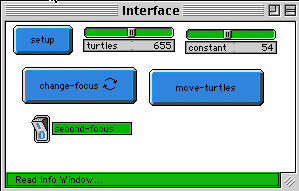
WHAT IS IT? ----------- The model displays two basic conic sections: circles and ellipses. The figures are generated behaviorally as opposed to algebraically- the turtles attempt to behave like points on the specified shape. The partner to this model is called 'Conic Sections-hyperbola¶b.' A circle is the set of all points at a certain distance (radius) from a central point. An ellipse is the set of points such that the sum of the distances to two points is constant. These two points are called foci. The CONSTANT slider corresponds to the radius for circles and to the sum of distances to the foci for each turtle. As an illustration of this, imagine a string loosely looped around two nails, each representing a focus. If you pull the string tight with a pencil point and move the pencil point around the foci, you will draw an ellipse. The ancient Greeks discovered that each conic section can be found by taking a cross section of one or two cones with their points pointing toward each other. A circle results from taking a slice that is perpendicular to the axis, while an ellipse results from taking a slice of one cone that is not perpendicular to the axis. Similiarly, a parabola results from a cross section that passes through one cone in a vertical fashion, such that the plane of the cut is parallel to one face. A hyperbola results from a vertical section that passes through both cones. The turtles use feedback to make decisions about how they behave. They set out in random directions, and then they receive information as to whether or not they are getting closer to where they want to be. If they are getting closer, they continue moving forward in the direction they are going. If they are moving farther away, they set out in a new random direction. This process is akin to the children's game of "Hot & Cold", in which players are told whether they are getting "hotter" or "colder" in relation to a hidden goal. HOW TO USE IT ------------- *Circles: -Select the number of turtles with the TURTLES slider. -Press SETUP. -Make sure the SECOND-FOCUS switch is set to 1. -Press the CHANGE-FOCUS button. CHANGE-FOCUS waits for a mouse click in the display window, and sets the circle's center to be that point. The center appears as a white dot. -Press the MOVE-TURTLES button. Adjust the radius of the circle with the CONSTANT slider. The turtles will automatically correct themselves as you change both CONSTANT and the location of the center. (You can change the circle's center by clicking on a new point as long as CHANGE-FOCUS is down.) *Ellipses: -Select the number of turtles with the TURTLES slider. -Press SETUP. -Make sure the SECOND-FOCUS switch is set to 0. -Press the CHANGE-FOCUS button. Then select two foci by clicking in two different areas. -Press the MOVE-TURTLES button. As for a circle, the size of the ellipse can be modified with CONSTANT, and new foci can be picked while MOVE-TURTLES is running. THINGS TO NOTICE ---------------- Notice that if CONSTANT is too large, the turtles will wrap onto the other side of the screen. This may give you some unsettled shapes- try lowering CONSTANT or enlarging the screen-size with the 'Settings' window in the Edit menu above. When forming a circle, turtles try to attain a distance of CONSTANT (a value determined by the user with a slider in the interface window) from a center that the user determines by pointing and clicking (as explained above). When forming an ellipse, turtles try to attain a combined distance of CONSTANT from the two foci, again determined by the user's points and clicks. THINGS TO TRY ------------- You may be able to get a better feeling for the turtles' behavior if only a few turtles are on-screen at one time. Try setting num to a small value (like 16 or 1) and watching the turtles. Both of these conic sections can be observed by shining a flashlight at a cone and looking at its shadow. Can you figure out at what angles the cone must be held? EXTENDING THE MODEL ------------------- Look at the StarLogoT model 'emergent-circle'. Watch how the turtles react with each other- something that is missing from 'Conic Sections'. Implement this emergent behavior for one or both of the conics in this project. STARLOGOT FEATURES ----------------- Like more traditional programming languages (e.g. C++), StarLogoT can have functions that return a value to the calling function. The command used is called 'output'- it has one argument, the value to be returned. Look at the function 'minus'. It takes one argument, num, and returns its negative, 0 - num. (The colon preceding num indicates that num is a local variable sent to the called function.) ; This model was created as part of the project: CONNECTED MATHEMATICS: ; MAKING SENSE OF COMPLEX PHENOMENA THROUGH BUILDING OBJECT-BASED PARALLEL ; MODELS (OBPML). ; The project gratefully acknowledges the support of the National Science ; Foundation (Applications of Advanced Technologies Program) -- grant numbers ; RED #9552950 and REC #9632612. ; ; Copyright 1996 by Uri Wilensky. All rights reserved. ; ; Permission to use, copy, or modify this software and its documentation for ; educational and research purposes only and without fee is hereby granted, ; provided that this copyright notice and the original authors' names appear ; on all copies and supporting documentation. For any other uses of this ; software, in original or modified form, including but not limited to ; distribution in whole or in part, specific prior permission must be ; obtained from Uri Wilensky. These programs shall not be used, rewritten, or ; adapted as the basis of a commercial software or hardware product without ; first obtaining appropriate licenses from Uri Wilensky. We make no ; representations about the suitability of this software for any purpose. It ; is provided "as is" without express or implied warranty.